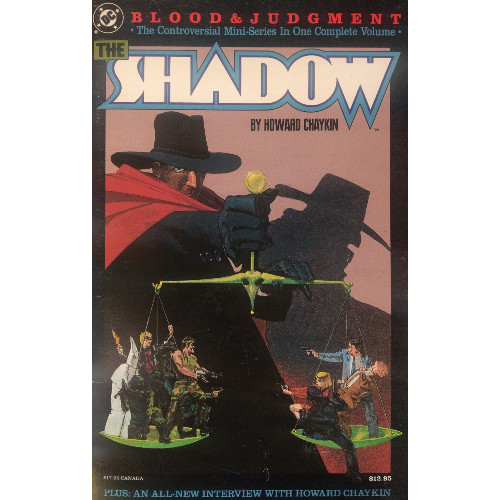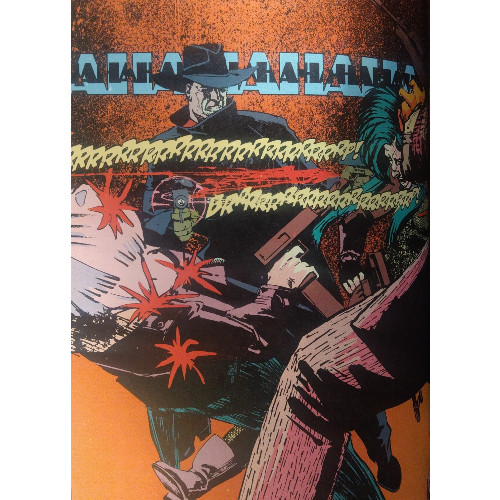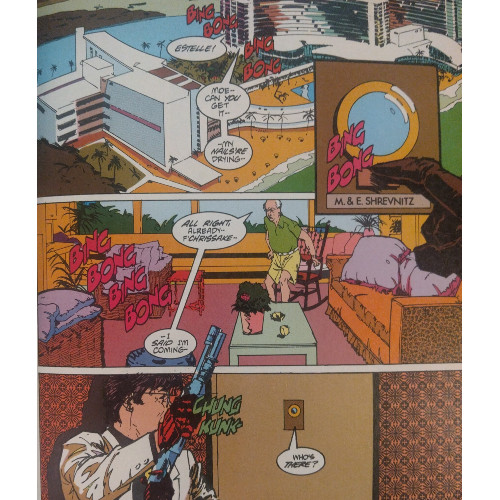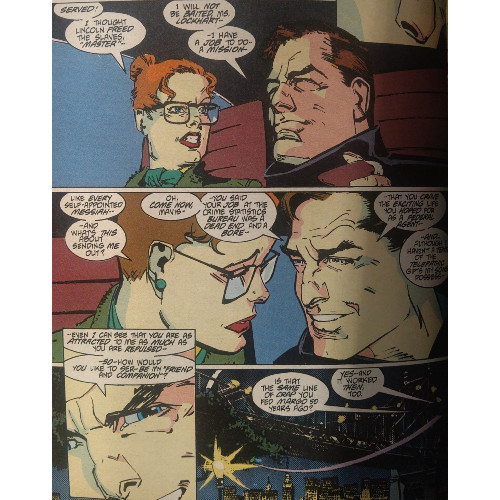Distinguished Critique: The Shadow: Blood and Judgment Review
Though divisive for different reasons, Howard Chaykin's series updates a vigilante who clings faithfully to his personality
—by Nathan on October 25, 2025—

I enter this review as a total novice as to who the Shadow is outside of him falling into the category of "pulp hero." The original magazine strips? Never read 'em. The radio drama? Never heard it. The Alec Baldwin movie? Never saw it. The same goes for comics, newspaper strips, or other adaptations. I know the character inspired Batman in part, and I recognized Dave Stevens' sneaky use of the character in his Rocketeer comics, but I know nothing about the guy himself.
As I noted in a review of DC's reprint of Marvel's full-color Doc Savage series from the 70s, I'm trying to, periodically, review some updated renditions of classic pop heroes, including guys like Doc Savage and the Spirit. DC seems to have done several of these modernized versions and have reprinted some of their own series as well as a few originally published by Marvel which DC then acquired along with certain characters.
Up next on my list: the man who knows what evil lurks in the hearts of men. Howard Chaykin rebooted the character in the late 80s for DC, and his four-issue limited series, though fairly well-known, is not without its controversies (though it seems it can't be a Howard Chaykin comic without ruffling a few feathers). We might have to wipe the blood from our eyes to peer past the shadows as we analyze what works in Chaykin's revitalization of this classic character.
The Shadow: Blood and Judgment
Writer: Howard Chaykin
Penciler: Howard Chaykin
Inker: Howard Chaykin
Colorist: Alex Wald
Letterer: Ken Bruzenak
Issues: The Shadow #1-4
Publication Dates: May 1986-August 1986

I don't know if Chaykin, in developing this limited series, ever had any discussions with Frank Miller, whose Dark Knight Returns saw its first issue published a month after the first part of Chaykin's series. On the surface, we see some similarities in the premise: a crime-fighter comes out of retirement after many years to team up with aged allies and face old adversaries threatening his home city. That's about where the resemblances between these series end, but it's curious that Chaykin toys with the concept of a vigilante re-emerging after an extended absence. One of the biggest differences between the two tales, however, is that the Shadow has not aged during his "retirement," looking as young as he did when he dropped off the map several years prior to this tale.
The mystery of the Shadow's youth is just one question Chaykin poses and suitably answers in this narrative. It means he can bring the character from his pulp, World War II-era roots without taking the "make him an old man" route, which I feel works better for the narrative. The Shadow's friends, accomplices, and even enemies have gotten older in the intervening years, but the Shadow has remained staunchly the same…and I don't necessarily mean by just avoiding the rigors of time. The Shadow keeping his youth allows him to throw on a hat and trenchcoat and deal out death to punks without complaining about his back or knees. Had Chaykin taken the "old man" direction, I'm sure the comparisons to Returns would be even more apparent to readers, so I am grateful that the Shadow, and his alter ego Kent Allard, were not aged.

As someone unaware of the original Shadow material, I found I was in a peculiar position reading Blood and Judgment, with a different take from how established fans of the character may feel about the series. Chaykin's story deals with the Shadow coming out of the, well, shadows, to avenge the deaths of several of his compatriots, allies and friends from older stories, who are brutally murdered in the first issue's opening pages. Here, I may find some agreement with readers who find the violence distasteful–it's certainly arbitrary, and though one could argue plot significance to it (seemingly random deaths to create misdirection?), the myriad methods feel a tad gauche by Chaykin. To certain readers, there may be a stunning visual appeal to the sight of a man shoved into a water cooler, but I found certain moments a little overzealous.
If anything, I would have hoped the murders to have some significance to the characters themselves. I kept googling names and flipping back and forth as I read, just to keep track of characters I was unfamiliar with, and I wondered if a bit more sinister intent could have been written into the killings. They're arbitrary, sure, and visually disturbing–the water cooler death, another man who is set on fire–but could they not have felt weightier in the moment? Chaykin defends the killings as arbitrary in an introduction, saying that's how life just sometimes works out, but I believe he could have found a clever way to incorporate something about the characters into their deaths. And it's not like these are killings disguised as accidents–no car crashes, no fake heart attacks. A dude gets stuffed into a water cooler! Go for broke, bad guys.
Though I guess it's hard to top stuffing a guy into a water cooler...

What I don't mind are the deaths themselves: I have no connection to the Shadow, no emotional link to his supporting cast, so Chaykin "thinning the herd," as it were, strikes me as an interesting way to set up a story. Picture all Batman comics being cancelled and then DC rebooting him thirty years later with a story where Alfred, Dick Grayson, James Gordon, and Vicky Vale are all murdered and the Dark Knight returning to solve the case. We would have, I'd imagined, separated ourselves enough from the character's original foundation to lessen the impact of such deaths, and I feel Chaykin does the same here. Fans of the Shadow may feel frustrated, but for the new reader, there is almost a graciousness in Chaykin removing character baggage from the story. It didn't prevent me from googling these folks and reading pieces of history anyway, but after that first issue, the potential "fluff" is reduced and your central characters and their intentions are cemented fairly well.
The more difficult piece to swallow and far more difficult to defend, if at all, in all of this–and the piece some readers may have appreciated Chaykin changing if he had–is the Shadow's misogynistic tendencies, with Allred making some derogatory comments and quips or treating women in a rude manner. Chaykin defends this as well, noting that Allred comes from a different time, and much like he hasn't aged physically, he's not grown philosophically or morally with the times themselves. He behaves like a man from a different era, cut off from society's growing conscience of people, and acts in ways which generally benefit himself at the (largely emotional) expense of others, mainly those closest to him. His former employees still refer to him as "master," a title which the level-headed secondary protagonist, Mavis Lockhart, derides, though she herself damages some of her credibility by succumbing late in the series to Allred's charms and making a few disparaging comments about other women herself.

It's a weird line Chaykin walks, a "have your cake and eat it too" kind of wire. If you tip a little this way, you'll see he wants to sound progressive and belonging to the era he's writing in, one where women have a greater voice and aren't afraid to correct the Shadow when he talks crudely. If you tilt a bit in the other direction, you'll see Chaykin peppers the script with offhanded comments that still embrace a male-centric perspective of people, leaning into storytelling mannerisms folks today would find discouraging. I don't think setting the Shadow up as a product of his era is a bad decision, and it does create some conflict between him and other characters, showing some of his naivety. The issue is that Allred is such a domineering force (remember, characters who haven't worked for him in years still refer to him as "master"), few folks stand up to him…or stand up to him for very long. Chaykin seems to not agree with the guy, but he doesn't do much to challenge the Shadow's opinions either.
Where Allred's limited perspective works more solidly is in how Chaykin pits him against the series' antagonists, particularly the punk thugs that his main adversaries set against the Shadow and his allies. Like Batman battles the mutants in Dark Knight Returns, so the Shadow is set against a new breed of violent criminals; though his brand of justice is also violent and deadly, he comes in with a practiced experience his opponents do not have. There's almost a "cool" factor these young punks try to embrace, which the Shadows bats aside with pure force and fear. My favorite sequence in Returns sees Bruce don the cape and cowl for the first time in years to venture out and nail several criminals who otherwise believe themselves safe. Chaykin devises a similar sequence, where Allred disappears and the Shadow enters the scene, walking through a fire, delivering his trademark laugh, and blowing his enemies away. He represents an old, backward way of thinking, but the Shadow also embodies clear principles of justice. Chaykin isn't asking you go out and murder your enemies, but in a world where people are grotesquely shoved into water coolers, the Shadow delivers a cleaner comeuppance. He's back, and as the character's oft-quoted tagline indicates, he's hunting the lurking evil he recognizes.

Chaykin's update of the Shadow is not without its dark patches, but I found that counterarguments can be offered for some of the complaints I've read. Yes, the series is violent, but the violence is tethered to the overarching narrative, and the Shadow makes a good case for his "violence begets violence" method of crime-fighting. Yes, Kent Allred embodies stereotypical ways of thinking for a man of his generation, and this creates uncomfortable moments, but it does allow for conflict to develop between him and a few other characters. I don't agree with all of Chaykin's decisions–Allred should be allowed some growth, I'd argue, and the initial deaths could be a bit more poetic–but there are interesting plot points here.
The series is divisive, frustrating at moments, and may make some people squirm. At its core, it presents an old character brought into a "modern" setting while retaining his own view of society and humanity, for better or worse. It's different from other updates you'll find on these cult characters–the Shadow enters the 80s, yet with his prior history and character intact (even if most of his supporting cast is shaken off like shed dog hair). He's not asked to change for the times, and even if he should in some instances, he maintains what makes him the Shadow. You may read this and not care for that interpretation, or for the classic character either, but regardless of opinion, this series is at least true to Allred's personality, both the light side and the dark corners.